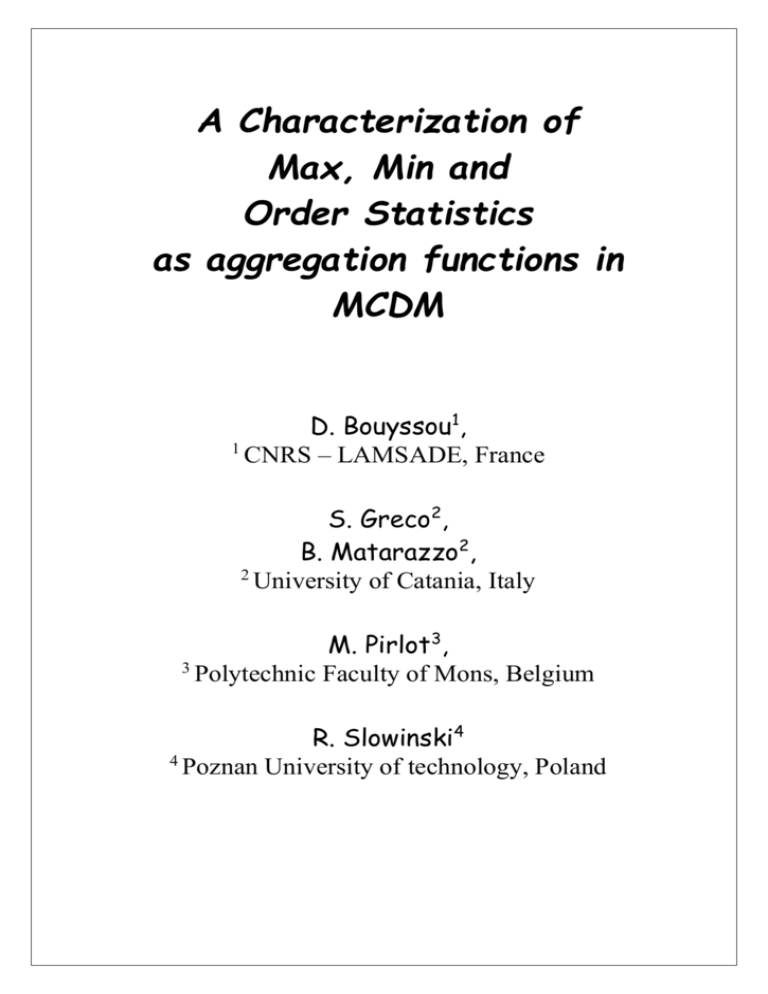Attributes
advertisement

A Characterization of
Max, Min and
Order Statistics
as aggregation functions in
MCDM
D. Bouyssou1,
1
CNRS – LAMSADE, France
S. Greco2,
B. Matarazzo2,
2
University of Catania, Italy
M. Pirlot3,
3
Polytechnic Faculty of Mons, Belgium
R. Slowinski4
4
Poznan University of technology, Poland
Context = Conjoint measurement
Set of objects evaluated on several attributes
A binary relation on the set of objects
Aim
Study/build/axiomatize numerical representations of the
binary relation
Interest of Numerical Representations
Manipulation of the binary relation
Construction of binary relations
Interest of Axiomatic Analysis
Tests of models
Understanding of models
Examples
Additive Utility (Debreu 1960, Luce – Tukey 1964)
n
n
i 1
i 1
x y u i (x i ) u i (yi )
Additive Difference Model (Tversky 1969, Fishburn 1991)
n
a f
x y i u i (x i u i (y i )) 0
i 1
Transitive Decomposable model (Krantz et al. 1971)
x y F(u1(x1), …, un(xn)) ≥ F(u1(y1), , …, un(yn))
Nontransitive Additive Model (Bouyssou 86, Fishburn 90, Vind
91)
n
x y pi (x i , yi ) 0
i 1
Aim : Similar analysis with Max, Min and Ordered Statistics
(“Ordinal” aggregation based on comparable “levels”)
Basic Elements
Attributes
i = 1, …, n
N = {1, …, n}
Domain of attribute i N
Xi
Evaluation space
n
X = Xi
i 1
Objects
xX
Large preference on X
xy
“x is at least as good as y”
Strict Preference on X
x y [x y and not y x]
“x is strictly preferred to y”
Notations
n
X–i = X j
j1, j i
XA = X i
iA
(xi, x–i) X
(xA, x–A) X
Maximum aggregation function
x y max[g(x1), …, g(xn)] max[g(y1), …, g(yn)]
n
where: g: X i R
i 1
Minimum aggregation function
x y min[g(x1), …, g(xn)] min[g(y1), …, g(yn)]
k th Ordered Statistics aggregation function
x y O(k)[g(x1), …, g(xn)] O(k)[g(y1), …, g(yn)]
where O(k)(r1, …, rn) = r(k)
where r(1), …, r(n) is a permutation of r1, …, rn such that
r(1) … r(n)
Max = O(n)
Min = O(1)
Max–min weighted sum
of m values r1, …, rn such that
0 rj 1 for all j N,
with respect to weights w1, …, wn
0 wj 1 for all j N
M(r1, …, rn ; w1, …, wn) =
n
Max Min rj , w j
j 1, 2,, n
Max–min weighted sum aggregation
function
xy
M[g(x1), …, g(xn) ; w1, …, wn]
M[g(y1), …, g(yn) ; w1, …, wn]
s
Min–max weighted sum
of m values r1, …, rn such that
0 rj 1 for all j N,
with respect to weights w1, …, wn
0 wj 1 for all j N
m(r1, …, rn; w1, …, wn)= min {max{rj, wj}},
j1,...,n
Min–max weighted sum aggregation
function
xy
m[g(x1), … , g(xn) ; w1, …, wn]
m[g(y1), …, g(yn) ; w1, …, wn]
Example of application of
Max–min weighted sum
to the problem of sorting students
Common ordinal scale for criteria
and weights of criteria
{bad, medium, good}
w(maths) = good
w(physics) = medium
w(lit.) = bad
Expression of preferences on all 27 cases
by max–min weighted sum
#
1
2
3
4
5
6
7
8
9
10
11
12
13
14
15
16
17
18
19
20
21
22
23
24
25
26
27
Maths
bad
medium
good
bad
medium
good
bad
medium
good
bad
medium
good
bad
medium
good
bad
medium
good
bad
medium
good
bad
medium
good
bad
medium
good
Physics
bad
bad
bad
medium
medium
medium
good
good
good
bad
bad
bad
medium
medium
medium
good
good
good
bad
bad
bad
medium
medium
medium
good
good
good
Lit.
bad
bad
bad
bad
bad
bad
bad
bad
bad
medium
medium
medium
medium
medium
medium
medium
medium
medium
good
good
good
good
good
good
good
good
good
Decision
bad
medium
good
medium
medium
good
medium
medium
good
bad
medium
good
medium
medium
good
medium
medium
good
bad
medium
good
medium
medium
good
medium
medium
good
Characterization of Max
When X is finite or countably infinite, the following
propositions are equivalent:
1) the preference relation on X satisfies the following
properties:
A1) The preference relation is complete and transitive,
i.e. it is a complete preorder,
A2) For all i = 1, …, n, xi, yiXi, a–i, b–i X–i and w X
[(xi, a–i) w] [(yi, a–i) w or (xi, b–i) w],
n
2) there is a function g: X i R such that:
i 1
x y max[g(x1), …, g(xn)] max[g(y1), …, g(yn)],
for all x, y X
Remarks
Necessary and sufficient conditions for Max
The characterization can be extended to cover the case
where X is not countably infinite: add a (necessary)
order density condition guaranteeing that has a
numerical representation
A preference relation can be represented with Max if
and only if it can be represented with weighted Maxmin
Interpretation of axiom A2)
A2) For all i N, xi, yi Xi, a–i, b–i X–i, w X
[(xi, a–i) w] [(yi, a–i) w or (xi, b–i) w],
can be written also as
[(xi, a–i) w and Not[(yi, a–i) w]] [(xi, b–i) w],
which means that if xi is “crucial” for the preference of
(xi, a–i) over w [(xi, a–i) w and Not[(yi, a–i) w]],
then xi allows the preference of (xi, b–i) over w [(xi, b–i)
w] for all b–iX–i .
Alternative equivalent formulations of
axiom A2) in presence of A1)
A2bis) For all x, yX and i N:
(xi, y–i) x or (yi, x–i) x
A2ter) For all i N, yi Xi, z–i X–i, x X
[(yi, x–i) x)] [ (yi, z–i) x],
Another axiomatic basis for the maximum
(J. Sounderpandian 1991)
X = Rn
Given G N
G=[1, …, n],
with i > 0 if i G and i = 0 otherwise
Axiom M. (Monotonicity) (x+{i}) x
for all x X, i N and {i} R
Axiom TES. (Total Exclusive Substitutability)
For all x X, i N, {i} R and N\{i} Rn–1
[x + {i} x] [x + {i} – N\{i} x].
Theorem (Sounderpandian 1991). The two following
propositions are equivalent:
P1) satisfies axioms M and TES,
P2) can be represented by Max
Other results with X = Rn
(Segal and Sobel 2001)
Advantage of our results on
the result of Sounderpandian
“It would be valuable to extend our results to
other types of criteria spaces [i.e. different from
the n–dimensional Euclidean space Rn] as well
because often a decision problem involves
qualitative or discrete variables”
(Sounderpandian 1991)
Characterization of Min
When X is finite or countably infinite, the following
propositions are equivalent:
1) the preference relation on X satisfies the following
properties:
A1) The preference relation is complete and transitive,
i.e. it is a complete preorder,
A2’) For all i N, xi, yiXi, a–i, b–i X–i and w X
[w (xi, a–i)] [w (yi, a–i) or w (xi, b–i)]
n
2) there is a function g: X i R such that:
i 1
x y min[g(x1), …, g(xn)] min[g(y1), …, g(yn)]
for all x, y X
Remarks
Necessary and sufficient– conditions for Min
The characterization can be extended to cover the case
where X is not countably infinite: add a (necessary)
order density condition guaranteeing that has a
numerical representation
A preference relation can be represented with Min if
and only if it can be represented with weighted Min–
max
Interpretation of axiom A2’)
A2’) For all i N, xi, yiXi, a–i, b–i X–i and w X
[w (xi, a–i)] [w (yi, a–i) or w (xi, b–i)]
can be written also as
[w (xi, a–i) and Not[w (yi, a–i)]]
[w (xi, b–i)]
which means that if xi is crucial for the preference of w
over (xi, a–i) [w (xi, a–i) and Not[w (yi, a–i)]],
then xi allows the preference of w over (xi, b–i)
[(xi, b–i) w] for all b–iX–i.
Alternative equivalent formulations of
axiom A2’) in presence of A1)
A2’bis) For all x, yX and i N
x (xi, y–i) or x (yi, x–i),
A2'ter) For all i N, yi Xi, z–i X–i, x X
[x (yi, x–i)] [ x (yi, z–i)],
Another axiomatic basis for the minimum
(J. Sounderpandian 1991)
X = Rn
Given G N
G=[1, …, n],
with i > 0 if i G and i = 0 otherwise
Axiom M. (Monotonicity) (x+{i}) x
for all x X, i N and {i} R
Axiom TN. (Total Nonsubstitutability)
For all x X, i N, {i} R and N\{i} Rn–1
[x x – {i}] [x x – {i}+N\{i}].
Theorem (Sounderpandian 1991). The two following
propositions are equivalent:
P1) satisfies axioms M and TN,
P2) can be represented by Min
Characterization of O(n – 1)
(second best value)
When X is finite or countably infinite, the following
propositions are equivalent:
When X is finite or countably infinite, the following
propositions are equivalent:
1) the preference relation on X satisfies the following
properties:
A1) The preference relation is complete and transitive,
i.e. it is a complete preorder,
A2’’) For all i, j N (i j), xi, yi Xi, xj, yj Xj, a–i X–i,
b–j X–j, c–{i, j}X–{i, j}, w X
[(xi, a–i) w and (xj, b–j) w]
[(yi, a–i) w or (yj, b–j) w or (xi, xj, c–{i, j}) w],
n
2) there is a function g: X i R such that:
i 1
xy
O(n – 1)[g(x1), …, g(xn)] O(n – 1)[g(y1), …, g(yn)],
for all x, y X
Remarks
Necessary and sufficient conditions
The characterization can be extended to cover the case
where X is not countably infinite: add a (necessary)
order density condition guaranteeing that has a
numerical representation
Analogous characterization for O(k)
Interpretation of axiom A2’’)
A2’’) For all i, j N (i j), xi, yi Xi, xj, yj Xj, a–i X–i,
b–j X–j, c–{i, j}X–{i, j}, w X
[(xi, a–i) w and (xj, b–j) w]
[(yi, a–i) w or (yj, b–j) w or (xi, xj, c–{i, j}) w],
can be written also as
[(xi, a–i) w and Not[(yi, a–i) w] and
(xj, b–j) w and Not[(yj, b–j) w]]
[(xi, xj, c–{i, j}) w]
which means that if
1) xi is crucial for the (large) preference of (xi, a–i) over
w [(xi, a–i) w and Not[(yi, a–i) w]],
2) xj is crucial for the (large) preference of (xj, b–j) over
w [(xj, b–j) w and Not[(yj, b–j) w]],
then
(xi, xj) allows the (large) preference of
(xi, xj, c–{i, j}) over w [(xi, xj, c–{i, j}) w]
for all b–{i, j}X–{i, j}.
Alternative equivalent formulations of
axiom A2’’) in presence of A1)
A2’’bis) For all x, yX and all i, j N with i j
[(xi, y–i) x and (xj, y–j) x] (yi, yj, x–{i, j}) x,
A2’’ter) For all x, yX, all i, j N with i j
and all z–{i, j} X–{i, j}
[(yi, x–i) x and (yj, x–j) x] [(yi, yj, z–{i, j}) x],
Another axiomatic basis for
the order statistics associated
to the k–th best argument
(in the style of J. Sounderpandian 1991)
X = Rn
Given G N
G=[1, …, n],
with i > 0 if i G and i = 0 otherwise
Axiom M. (Monotonicity) (x+{i}) x
for all x X, i N and {i} R
For all x X, i N, {i} R and N\{i} Rn–1
[x x – {i}] [x x – {i}+N\{i}].
Axiom TES(k). (k–exclusive substitutability)
For all x X, all G N with card(G)=k, all G Rk and
N\G Rn–k
[x + G x] [x + G – N\G x]
Theorem. The
equivalent:
two
following
propositions
P1) satisfies axioms M and TES(k),
P2) can be represented by O(n–k)
Open Problems
Questions for future research
are
Max, Min and O(k) have common features
use these common features in the axiom
system
Characterize the whole family of Ordered
Statistics (k not specified)
Use these results as a basis for more
general models
Sugeno
Choquet








